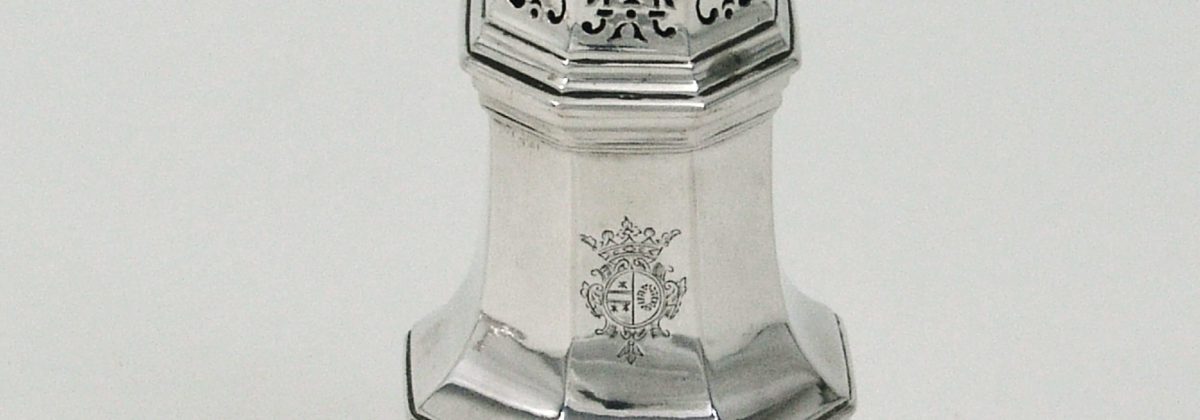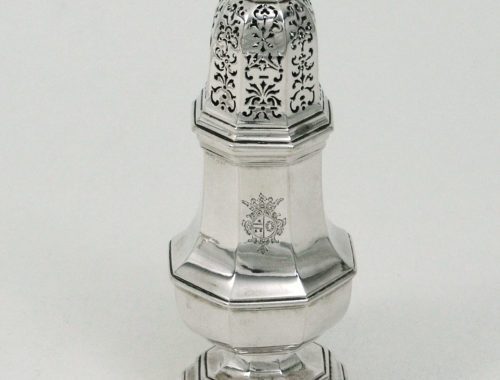Object number #
Hannover, ca. 1730/40
Bernhard Hinrich Corthnum
Hallmark: a cloverleaf for Hannover (Scheffler 1965: no 1374)
Maker’s mark: Monogram „BNC“ in a shield in the form of a leaf for Bernhard (Berend) Heinrich Cortnum (Scheffler 1965: no 1375)
Heraldry: coat of arms of the noble family von Schilden
Height: 23,8 cm (9,05 in.); weight: 530 gr.
Detailed Information
Silver Sugar Caster
This antique silver sugar caster is of an unusually heavy quality and a very fine preserved object, typical for the 18th century in North Germany. The caster has an octagonal, pear-shape and is raised on a profiled foot and closes with a lid. The body has moreover a baluster and eight edges. The engraved coat of arms of von Schilden adorns the one side of the wall. The pull off lid is pierced, presenting a foliations décor and has a cast finial.
This caster is because of its size used for strewing sugar. Sugar casters were invented in France and were quite big in size. Around 1700, the sugar caster was made in elegant baluster forms; a popular form and object in whole Europe indeed.
Provenance
The engraved coat of arms belongs to the noble house von Schilden. The coat of arms is split; on the left field, in the middle, there is a horizontal beam, above which there is a star and below it there are two stars. On the right field, there is a wreath.
The von Schilden were raised to nobility in 1738, in the person of the brothers Schilden: Heinrich Andras auf Haseldorp, Jacob Christoph, cash commissars at the electorateof Brunswick, and Bodo Friedrich, royal administrator on the side of Westrow, together with their sister, married to von Thulemeyer, with whom she was raised to the imperial peerage.
Anna Henriette, daughter of Heinrich Andreas von Schilden, was the inheritress of the heritage of her father and she was moreover raised to the empire’s nobility in Vienna in 1751, with the title “noble von Schilden”. She had married in 1744 to Carl Friedrich Frick von Friccius, who, in 1751, received in Vienna a confirmation of the empire’s peerage as a councillor of the Danish state.(Siebmacher 1977: Bd. 19/30/T. 15).
The sugar caster, probably with other objects, was most probably given as an order around 1738, after the ennobling of the brothers Schilden.
Maker
Bernhard (Berend) Heinrich Cortnum was son of a butcher in Hannover. He was baptised on the 24thApril 1687 and got married as a citizen, gold- and silversmith to Anna Ilse Hansemann on the 6thof October 1716. He got married for a second time in 1737 and died as a deacon in 1754. His son Eberhard Anthon was also a silversmith.
Literature
Gruber, Al., 1982, Gebrauchssilber des 16. bis 19. Jahrhunderts, Würzburg: Edition Popp.
Scheffler, W., 1965, Goldschmiede Niedersachsens: Daten – Werke – Zeichen, 2. Halbband, Aerzen-Hamburg, Berlin: De Gruyter.
Siebmacher, J., 1977, Die Wappen des niederdeutschen Adels, Bd. 19, Neustadt an der Aisch: Bauer & Raspe.
Von Rohr, Al., 1993, Edles Tafelgerät: Silber aus dem Historischen Museum Hannover, Historisches Museum Hannover.



